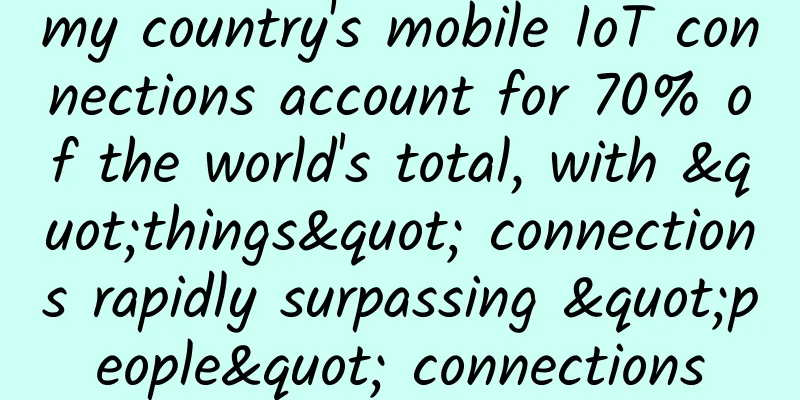my country's mobile IoT connections account for 70% of the world's total, with "things" connections rapidly surpassing "people" connections

|
On January 30, it was learned from the Ministry of Industry and Information Technology that the scale of my country's mobile Internet of Things users is expanding rapidly. As of the end of 2022, the number of connections reached 1.845 billion, a net increase of 447 million households from the end of 2021, accounting for 70% of the global total. By the end of 2022, the total number of mobile communication base stations will reach 10.83 million, with a net increase of 870,000 throughout the year. my country has initially formed a pattern of coordinated development of narrowband Internet of Things (NB-IoT), 4G and 5G networks, and network coverage capabilities continue to improve. Among them, the scale of narrowband Internet of Things is the largest in the world, achieving continuous coverage of major cities and towns in the country; 4G network has achieved universal coverage in urban and rural areas across the country; 5G network has covered all county towns. The number of mobile Internet of Things connections is growing rapidly, and "things" connections are rapidly exceeding "people" connections. Statistics show that by the end of 2022, the total number of terminal connections in my country's mobile networks has reached 3.528 billion, of which the number of mobile Internet of Things terminal users representing "things" connections is 161 million higher than the number of mobile phone users, accounting for 52.3% of the number of mobile network terminal connections. Application scenarios are constantly enriched and the industrial chain is continuously improved. my country has formed a relatively complete mobile Internet of Things industrial chain covering chips, modules, terminals, software, platforms and services. Narrowband Internet of Things has formed 4 million-level applications such as water meters, gas meters, smoke sensors, and tracking, and 7 million-level applications such as white goods, street lights, parking, and agriculture. The scale of mobile Internet of Things terminals used in public services, Internet of Vehicles, smart retail, and smart homes has reached 496 million, 375 million, 250 million, and 192 million households, respectively. Industry applications are constantly expanding to smart manufacturing, smart agriculture, smart transportation, smart logistics, and consumer Internet of Things. A relevant official from the Ministry of Industry and Information Technology said that during the 14th Five-Year Plan period, deep coverage of mobile Internet of Things networks will be achieved in key scenarios, forming a basic network that integrates fixed and mobile, and combines broadband and narrowband networks. This will accelerate the coordinated integration of mobile Internet of Things technology with thousands of industries and sectors, promote better quality and efficiency of economic development, make social services intelligent and efficient, and make people's lives convenient and fast. |
<<: How to use ip command to manage network in Linux
>>: Still using OpenFeign? Try this new thing in SpringBoot3!
Recommend
ICO was wiped out, is blockchain technology a blessing or a curse?
In the first half of this year, with the skyrocke...
IPv6+, a new starting point for the next generation Internet
As of July 2020, the number of users allocated IP...
TmhHost Hong Kong three network CN2 GIA monthly payment starts from 45 yuan, US CN2 GIA high defense VPS quarterly payment starts from 99 yuan
TmhHost is a regular domestic company with ISP\IC...
5G construction has not yet been completed, and countries have invested heavily in 6G research. Will my country still be ahead in 6G?
Whoever masters advanced network technology first...
Kubesphere deploys Kubernetes using external IP
Our company has always had the need to connect al...
The second decade of cloud computing: How will the three major operators welcome it?
In 2018, my country's cloud computing entered...
5G: Base stations are being built crazily, but utilization rate cannot keep up, with only 3% coverage?
At present, the number of 5G base stations in Chi...
5G empowers the transformation and upgrading of the banking industry. How should banks innovate in the 5G era?
Recently, China Mobile and Industrial and Commerc...
VIAVI Launches New Test Solution for Network Equipment Manufacturers and Labs, Paving the Way for 800G Next-Generation Networks
VIAVI Solutions (NASDAQ: VIAV) today announced a ...
[11.11] UFOVPS 30% off, top up 200 yuan and get 20 yuan, Japan/Hong Kong CN2 GIA/US high defense optional
UFOVPS has launched a promotion during the Double...
Alibaba Gumo: Decoding the evolution of Taobao's intelligent customer service architecture
[51CTO.com original article] The WOTD 2017 Global...
Why is 5G considered the criterion for the Internet of Things era?
With the advent of the 4G era, the Internet indus...
"Interview Eight-part Essay" Network Volume 19
[[422375]] 1.How many layers does the TCP/IP netw...
DigitalVirt: Los Angeles AS9929 line starting at 39 yuan/month, 1GB/20G NVMe/1TB monthly traffic
DigitalVirt is a Chinese hosting company founded ...
What exactly is “split brain” in distributed systems?
[[413929]] This article is reprinted from the WeC...
![[11.11] iOVZ: 60% off monthly payment/50% off annual payment for all VPS/dedicated servers, Hong Kong/Korea VPS monthly payment starts from 36 yuan](/upload/images/67cabd2aaf03f.webp)








